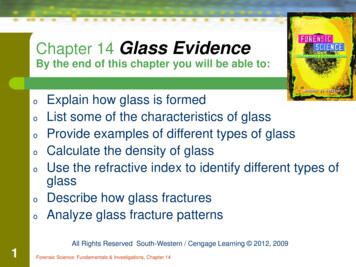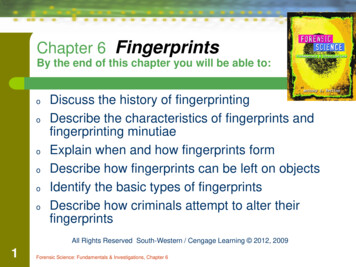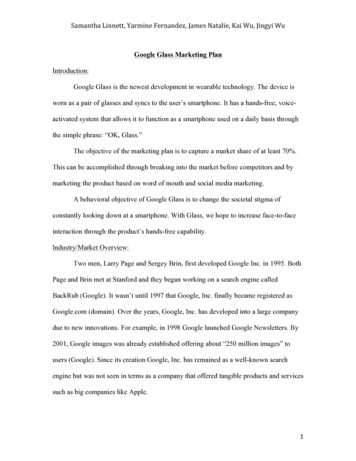
Transcription
Chapter 14 Glass EvidenceBy the end of this chapter you will be able to:oooooooExplain how glass is formedList some of the characteristics of glassProvide examples of different types of glassCalculate the density of glassUse the refractive index to identify different types ofglassDescribe how glass fracturesAnalyze glass fracture patternsAll Rights Reserved South-Western / Cengage Learning 2012, 20091Forensic Science: Fundamentals & Investigations, Chapter 14
Introduction and History of Glassooo2Egypt circa 2500 B.C.—The earliest knownhuman-made glass objects (beads)1st Century B.C.—glass blowing begins13th Century—specialized glass productionwas an art, a science, and a state secret in therepublic of VeniceForensic Science: Fundamentals & Investigations, Chapter 14
Introduction and History of Glassooo314th Century—glass-making spreads throughEuropeThe industrial revolution applies massproduction to many types of glassAnalysis of glass found at a crime scene canyield trace evidenceForensic Science: Fundamentals & Investigations, Chapter 14
What Is Glass?oo4Materials used to create (soda-lime) glass: Silicon dioxide (SiO2) Sodium oxide (Na20) Calcium oxide (CaO)Once cooled, glass can be polished, ground,or cutForensic Science: Fundamentals & Investigations, Chapter 14
What Is Glass?5oCrystalline solids have aregular atomic structureoGlass is an amorphous solidand so has an irregularatomic structureoTherefore, glass breaks in avariety of fracture patternsForensic Science: Fundamentals & Investigations, Chapter 14
Types of Glassooooo6Many types of glassAdding metal oxides yields different colorsDifferent densitiesRefraction indexesThese characteristics allow comparisonsForensic Science: Fundamentals & Investigations, Chapter 14
DensityThe formula for calculating density is:D m/Vom mass, measured by a balance beamdeviceoV volume, place the glass fragment into abeaker filled with water and measure theoverflowoD density, divide the mass (in grams) bythe volume (in milliliters)7Forensic Science: Fundamentals & Investigations, Chapter 14
Density—Common Examples8Type of GlassDensity (g/ml)Bottle glass2.50Window glass2.53Lead crystal2.98-3.01Pyrex2.27Tempered (auto)2.98Flint3.70Crown2.50Forensic Science: Fundamentals & Investigations, Chapter 14
Refractive IndexoWhen a beam of light moves from onemedium into another: oo9The speed changesThe direction bendsRefractive Index—a tool used to study howlight bends as it passes from one substanceto anotherNormal line is perpendicular to the glasssurfaceForensic Science: Fundamentals & Investigations, Chapter 14
Refractive IndexWhen a beam of lightmoves from less densemedium (air) into a moredense medium (water): Its speed slows, and Bends light towardthe normal line10Forensic Science: Fundamentals & Investigations, Chapter 14
Refractive IndexWhen a beam of lightmoves from a more densemedium (glass) into a lessdenser medium (air): Its speed increases And bends light awayfrom the normal line11Forensic Science: Fundamentals & Investigations, Chapter 14
Application of Refractive Indexto ForensicsSubmersionmethod—usedwhen glassfragments foundat the crimescene are small12Forensic Science: Fundamentals & Investigations, Chapter 14
Application of Refractive Indexto Forensicsoo13Place the glassfragment into differentliquids of knownrefractive indexesThe glass fragment willseem to disappearwhen placed in a liquidof the same refractiveindexForensic Science: Fundamentals & Investigations, Chapter 14
Application of Refractive Indexto ForensicsoBecke Line—a halo-like effect appearing atthe edges of a glass fragment when thereflective index of the glass and liquid aredifferent If the line is inside the glass perimeter, the glassindex is higher than the index of the liquid If the line is outside the glass perimeter, the glassindex is lower14Forensic Science: Fundamentals & Investigations, Chapter 14
Fracture Patterns inBroken Glassoo15Being an amorphous solid, glass will notbreak into regular pieces with straight linefracturesFracture patterns provide clues about thedirection, rate, and sequence of the impactsForensic Science: Fundamentals & Investigations, Chapter 14
Why Radial and ConcentricFractures Formooo16Impacted glass is compressed on the side it is hit.It will stretch on the opposite side of the glass, andthe tension there will radiate breaks in the glassoutward from the point of impact.Then fractures form in the shape of concentriccircles on the same side of the impact.Forensic Science: Fundamentals & Investigations, Chapter 14
Why Radial and ConcentricFractures FormGlass after an impactshows radial fractures (red)and concentric circlefractures (blue)17Forensic Science: Fundamentals & Investigations, Chapter 14
Why Radial and ConcentricFractures Form18Forensic Science: Fundamentals & Investigations, Chapter 14
Bullet Fracturesooo19As a bullet passes through glass, it pushes a coneshaped piece of glass out of the glass ahead of itThe exit side of the hole is larger than the entranceside of the holeRadiating fracture lines from a subsequent shot willstop at the edge of the fracture lines already presentin the glassForensic Science: Fundamentals & Investigations, Chapter 14
Path of a Bullet Passingthrough Window Glassperpendicularto the glassoo20shot fromthe leftshot fromthe rightThe angles at which bullets enter window glasshelp locate the position of the shooterBits of the glass can fly backward (backscatter),creating trace evidenceForensic Science: Fundamentals & Investigations, Chapter 14
Handling of Crime SceneGlass Samples1. Identify and photograph any glass samples before2.3.4.5.6.21moving them.Collect the largest fragments that can be reasonablycollected.Identify the outside and inside surface of any glass.If multiple panes are involved, make a diagram.Note trace evidence such as skin, hair, blood, orfibers.Package all materials collected to maintain the chainof custody.Forensic Science: Fundamentals & Investigations, Chapter 14
. . . . . . . . . . . . . Summary . . . .oooo22Glass is an amorphous solidGlass can be analyzed for its density,refractiveness, and fracture patternsDensity of glass Mass (grams) divided byVolume (milliliters)Refractive index is a measurement of how lightbends, or refracts, as it travels through amaterialForensic Science: Fundamentals & Investigations, Chapter 14
. . . . . . . . . . . . . . . . . SummaryoMethods for measuring the refractive indexinclude: Snell’s law Submersion method Becke line methodo23Fracture patterns provide information aboutsuch things as the direction, the rate, and thesequence of the impactsForensic Science: Fundamentals & Investigations, Chapter 14
16 Forensic Science: Fundamentals & Investigations, Chapter 14 Why Radial and Concentric Fractures Form o Impacted glass is compressed on the side it is hit. o It will stretch on the opposite side of the glass, and the tension there will radiate breaks in the glass outward from the point of impact. o Then fractures form in the shape of concentric .










